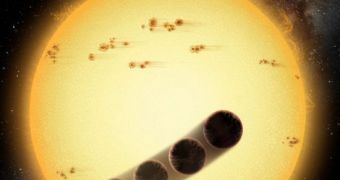As astronomers discover more and more extrasolar planets, they are also finding some that are orbiting their stars in a retrograde orbit, as in the opposite direction than their star's spin. Experts now propose a new explanation for why this is happening.
Determining the reason that underlies this peculiar behavior has been a goal for scientists ever since the first retrograde exoplanet was found, not long ago. Though numerous hypothesis were set forth until now, none managed to capture the essence of this peculiar state of affairs.
The weird spin was only found to exist in planetary objects of the hot Jupiter class, which means that it affects bodies that are at least the size of our gas giant, or larger. The term hot Jupiter refers to a massive exoplanet that orbits very close to its parent star.
This causes temperatures on the object's day surface to reach extremes, while the night side is frozen all the time. Hot Jupiters are usually tidally locked with their parent stars, similarly to how the Moon is locked to Earth and Mercury to the Sun.
What experts determined in the new investigation was that the exoplanets featuring a retrograde orbit – about a quarter of all-known hot Jupiters – had had their orbits severely perturbed by other massive planets moving around the same star.
These orbital interferences influenced their paths around the parent star to such an extent that their orbit at times flipped 180 degrees, setting the hot Jupiter on a retrograde course. However, this explanation does not sit well with our current understanding of planetary formation.
For starters, all the planets, moons and asteroids in a star system come from the same protoplanetary cloud of material, which forms around a newly-condensed stellar object. As such, it stands to reason that all objects would spin and rotate in the same direction.
“Because all of this comes from the same initial swirling cloud of gas, very naturally the picture is one in which the star is spinning, and everything around it is spinning in the same direction,” Northwestern University astrophysicist Frederic A. Rasio explains.
Northwestern postdoctoral fellow Smadar Naoz led the team of investigators that conducted the new study. Rasio was the senior scientist for the group. Details of the work appear in the May 12 issue of the top journal Nature.
“There aren’t many things that can change the orbit of a big planet like that so drastically. The candidates are pretty obvious, and the one we looked at is to simply have another big planet in the system farther out,” Rasio says, quoted by Space.

 14 DAY TRIAL //
14 DAY TRIAL //